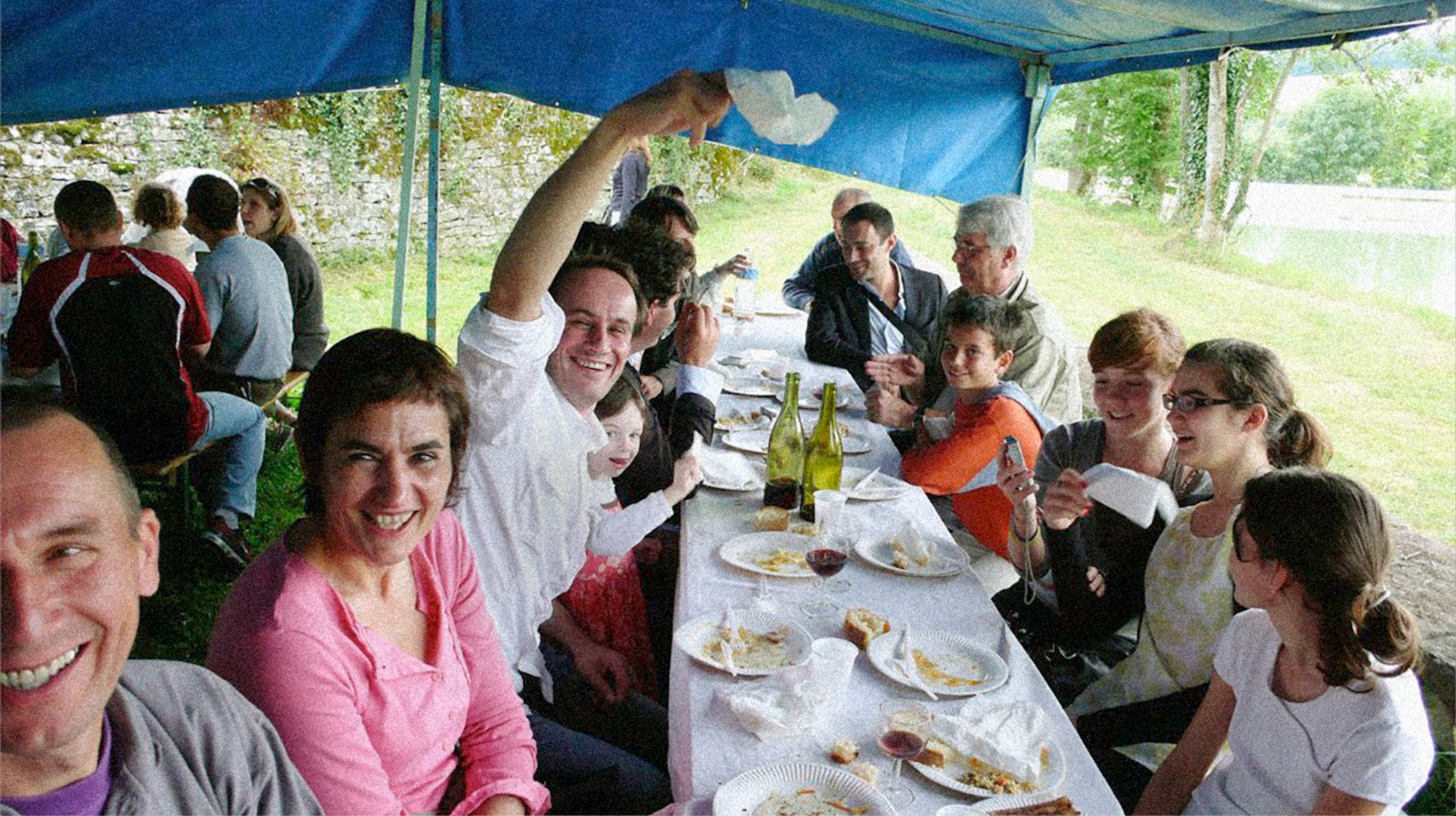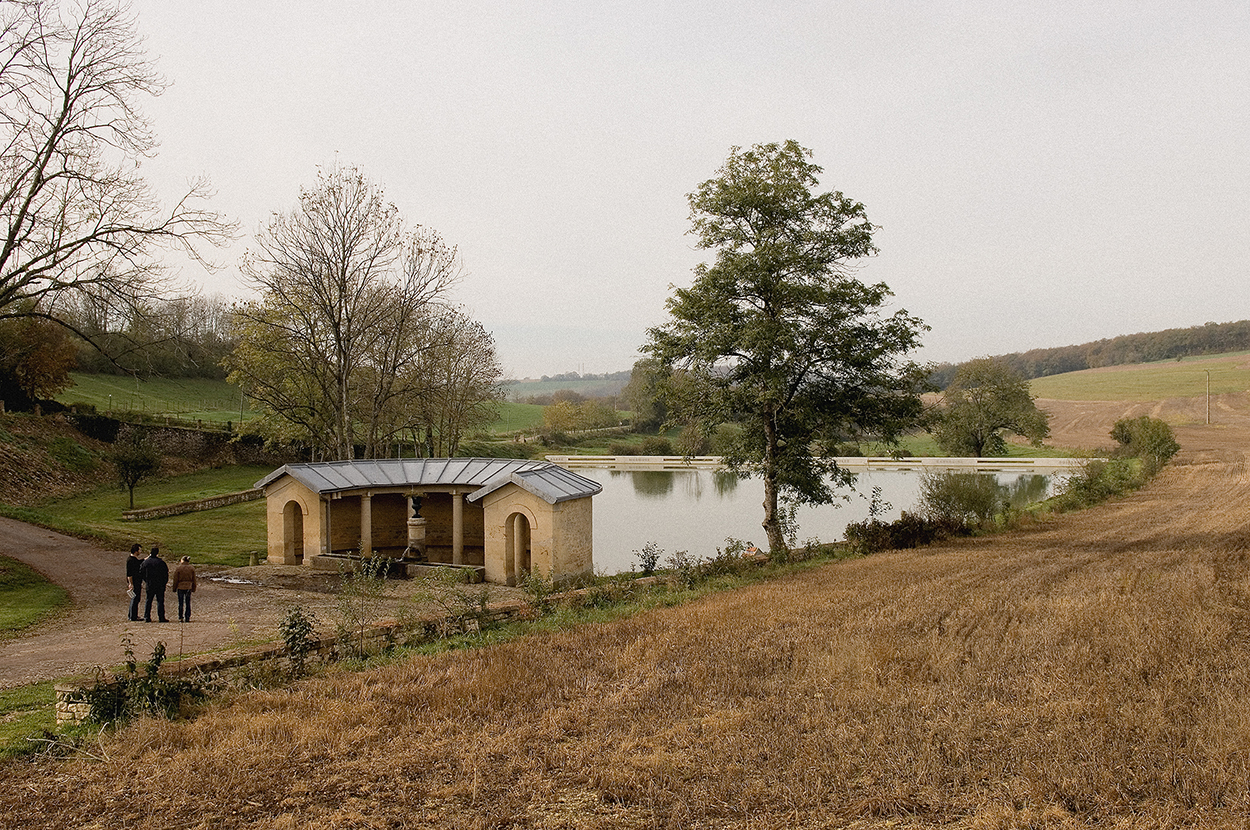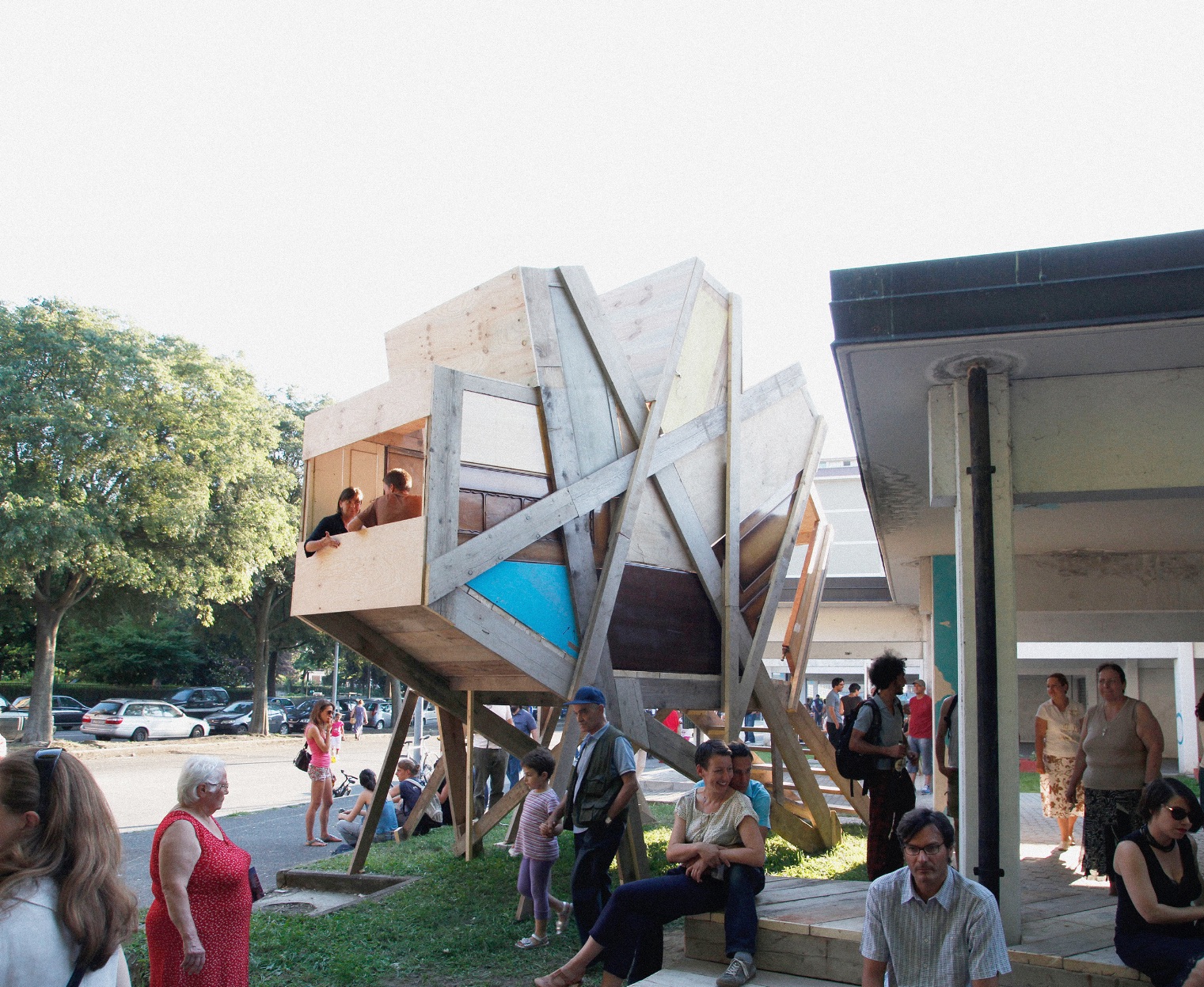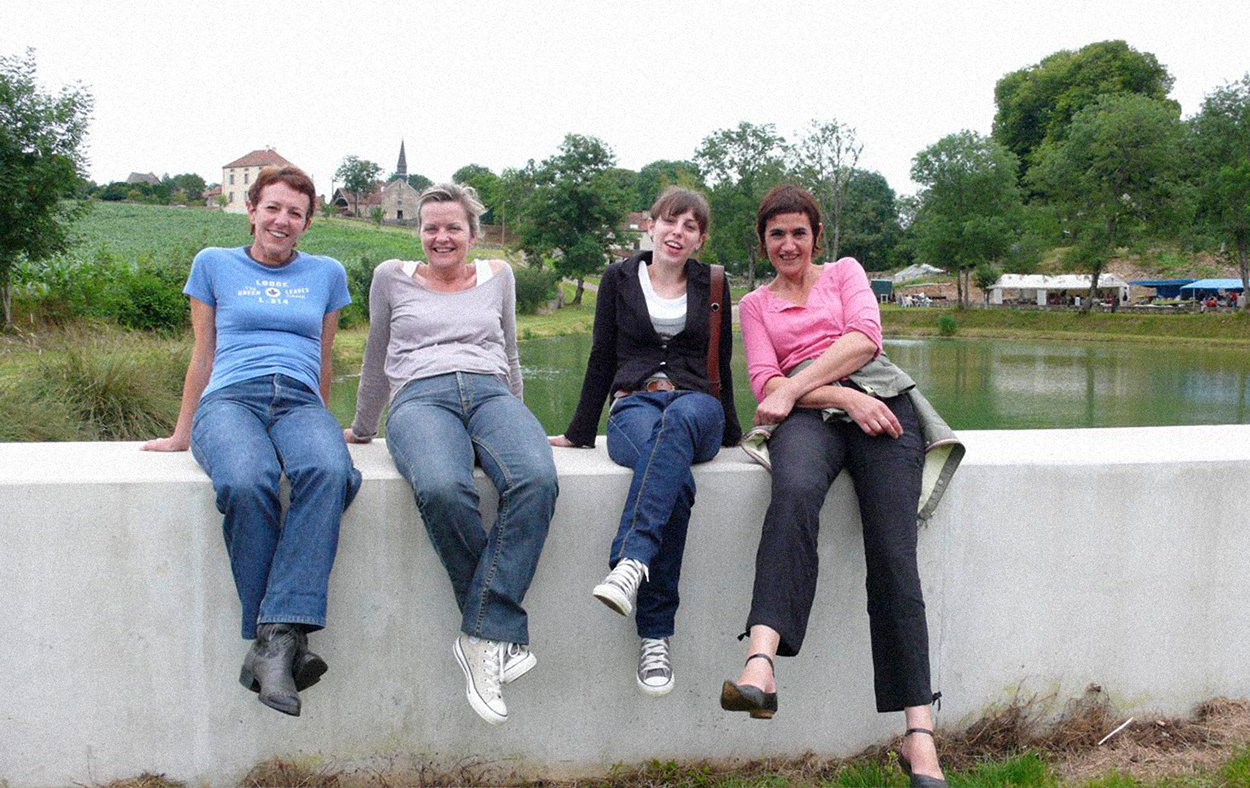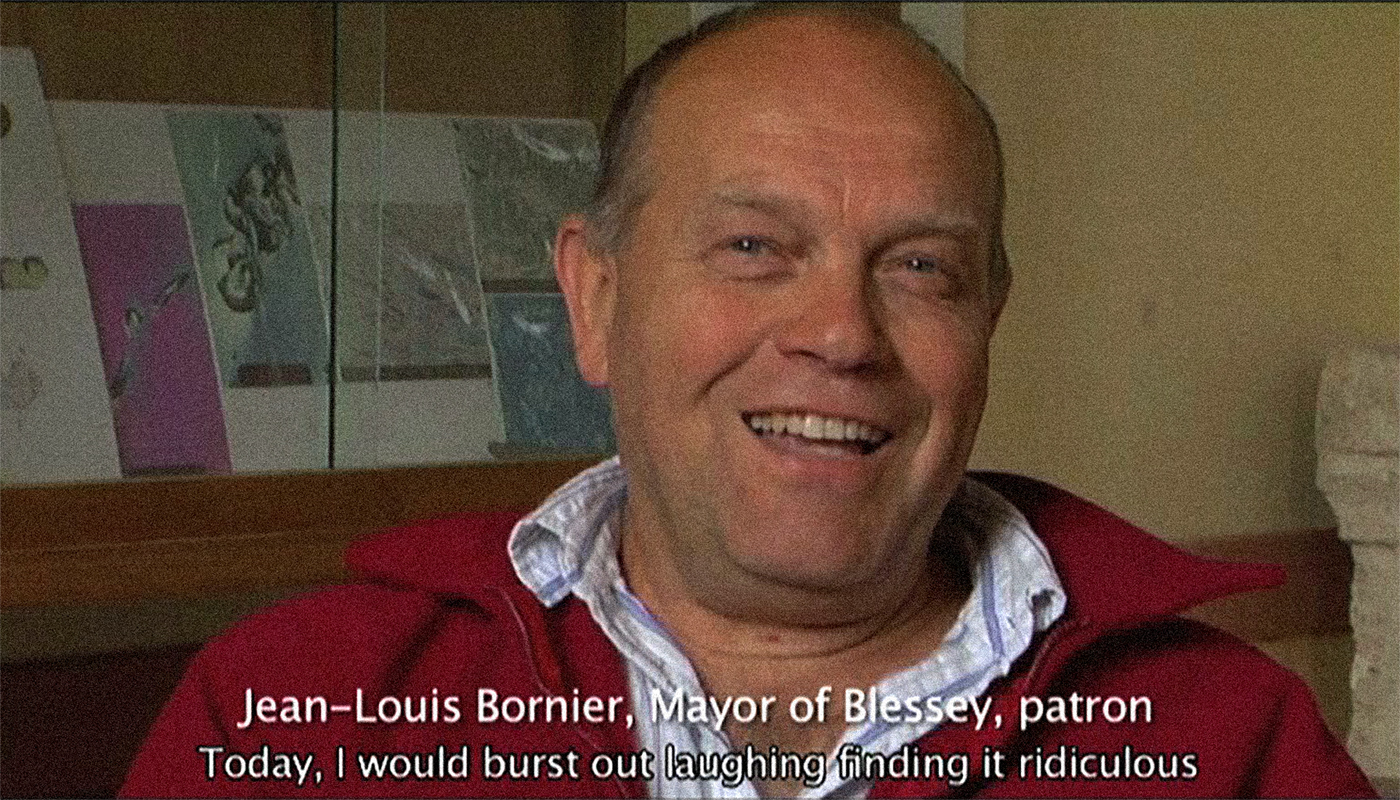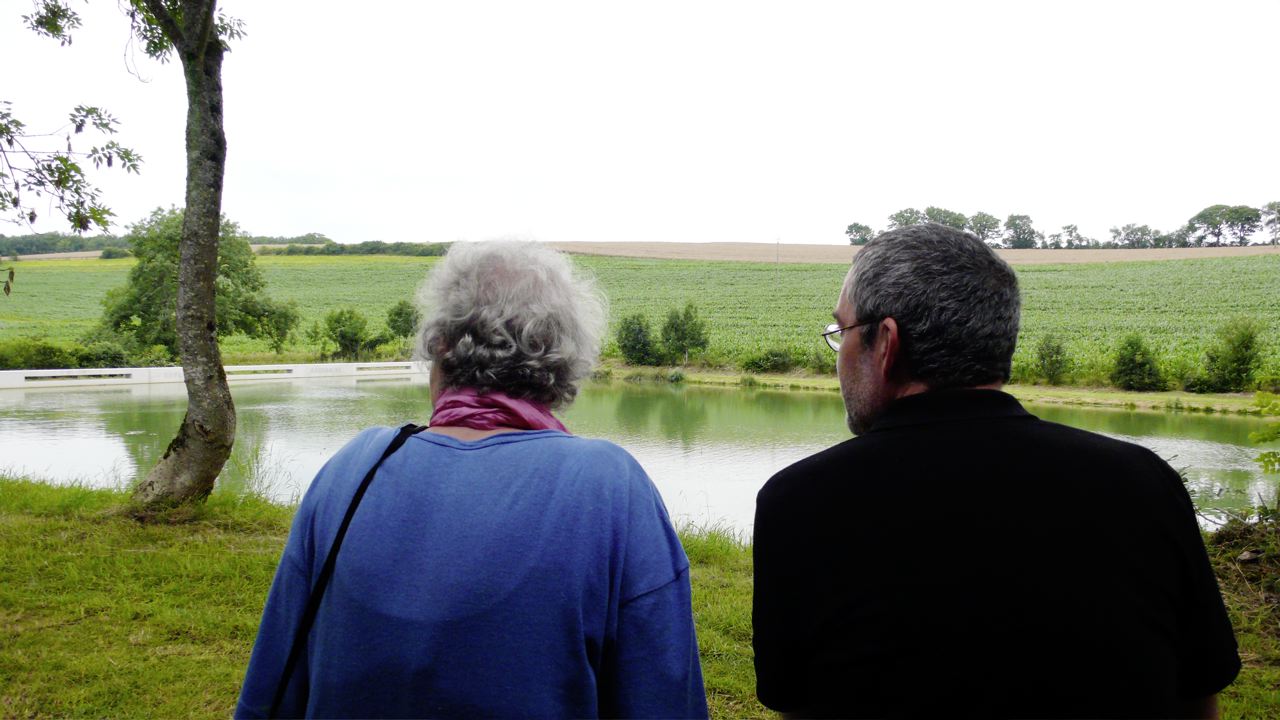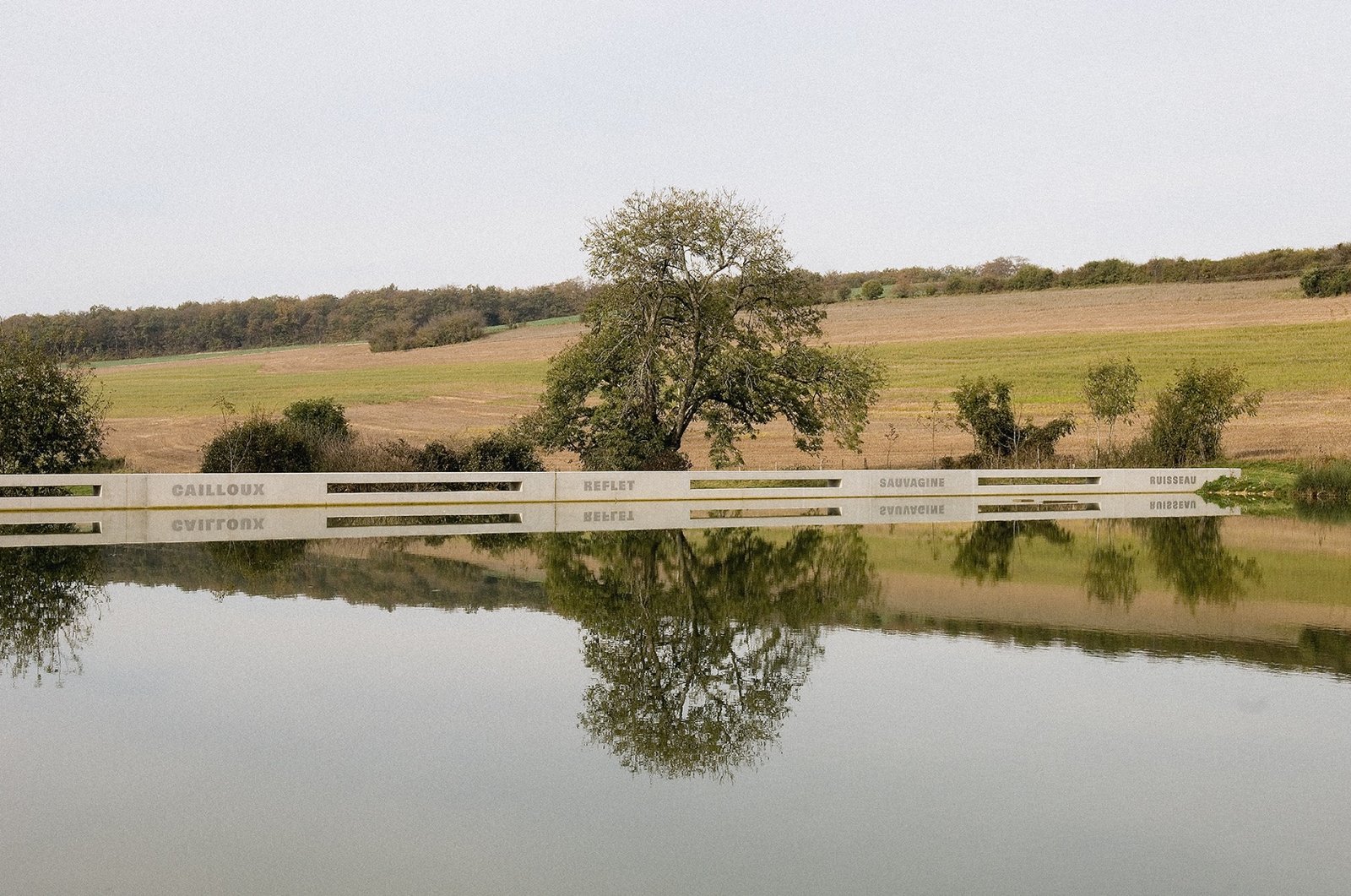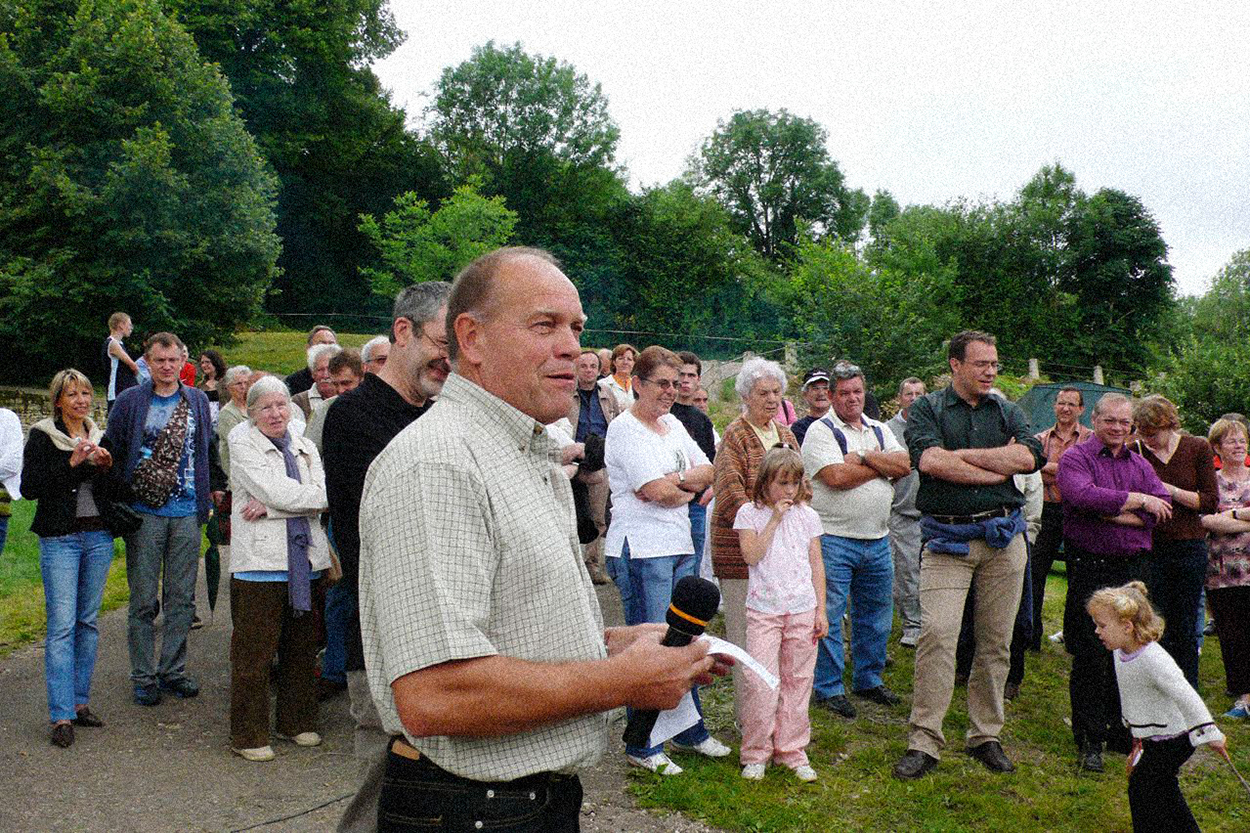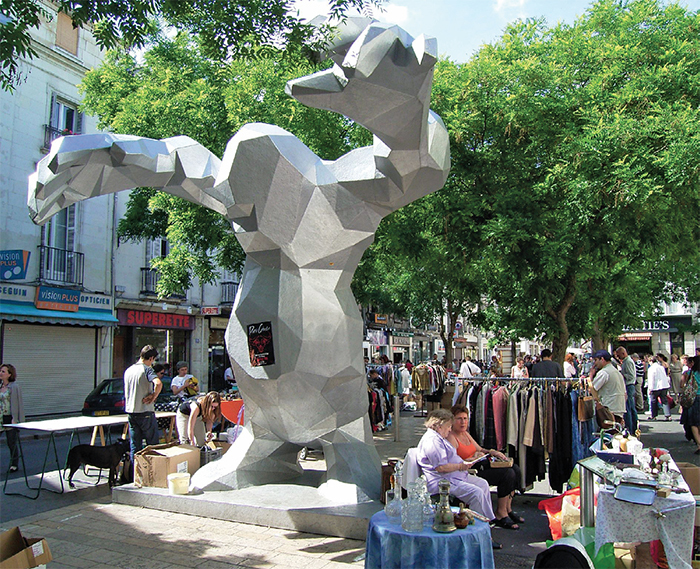Isabelle Stengers
This text by philosopher Isabelle Stengers, available for the first time in German, uses the project The Washhouse of Blessey to illustrate the democratic potential of the New Patrons model. Her contribution describes how, in the process of commissioning and realising artworks, civil society groups empower themselves and become aware of their own capacity to shape their community.
The project The Washhouse of Blessey was commissioned by the citizens of the village of Blessey in Burgundy, France, between 1997 and 2007, in collaboration with the artist Remy Zaugg and the mediator Xavier Douroux. It is considered one of the most impressive projects in the 30-year history of the New Patrons. The documentary film The New Patrons of Blessey, in which the commissioners take a look back on the project, is an essential starting point for Stengers’ reflections.
Isabelle Stengers, a Belgian philosopher born 1949, became known for her work with the Russian-Belgian chemist and 1977 Nobel prize winner Ilya Prigogine. She then turned to the history and philosophy of science. She has written widely about the need to resist the positivist authoritarian model of science, thinking with philosophers such as Gilles Deleuze, Alfred North Whitehead, Donna Haraway and Michel Serres, and with the French philosopher and sociologist Bruno Latour, among others.
Stengers’ text was originally written for the publication Faire art comme on fait société (les presses du réel). Published in 2013, the reader encompassed for the first time a broad field of theoretical perspectives on the programme of the New Patrons. In 2017, the adapted and supplemented English-language edition Reclaiming Art. Reshaping Democracy (les presses du réel) was released.
“Because now I would feel authorized to do it...” It is in this way that the mayor of the very small commune of Blessey explains that he would chuckle if someone proposed the same kind of refurbish- ment he had previously envisaged for his restored wash house today. These words, and other things said by the inhabitants of Blessey will probably be quoted by many of the contributors to this volume, because they testify—in a manner that is at least as eloquent as the site itself—to what the success of the New Patrons’ gamble might signify.
Since the 19th century it has been said that the artist is a seer. But that has become an astoundingly banal expression, or worse, something that is synonymous with what an inhabitant of Blessey calls the “struggle of the cultural classes,” because the primary meaning of “seer” today seems to designate “people”—the others— as blind, unable to understand, even though one exhausts oneself enlightening them, explaining things to them. One hears it said that the “public” stays away from “its” art, from the art of its epoch. But it is also said that people feel themselves to be scorned, and their “sulking” could well be a refusal of the humiliating position in which they have been placed.
An unhealthy situation, but when all is said and done, no more unhealthy than the situation that prevails everywhere, in each situation when what is called democracy ends up being summed up as the art of guiding a flock with the minimum of recalcitrance, local turbulence, perhaps, but global docility. In particular, it is no more unhealthy than the situation that prevails around the production of scientific knowledges. To be sure, the words change: scientists are not “seers” but “objective.” However, there too the primary—sometimes the only—meaning is to disqualify “people,” in this instance to dismiss what is called “Opinion,” defined by its beliefs and its suggestibility.
The words of the mayor of Blessey tell us two things. First, that it is not a matter of attributing to those who are excluded a knowledge or an imagination that demands only to be recognized—a temptation that perhaps refers to a Christian culture that places truth on the side of the victims. Rémy Zaugg, the artist sponsored by the inhabitants of Blessey did not—this is the least one can say— give in to this temptation. Far from honoring the initiative of the village, which had already found the money to restore its ancient wash house, he let those concerned know that this “punctual and exclusive” safeguarding of the village’s heritage made manifest “the physical and perhaps psychic, at the very least the cultural, dilapidation of the surrounding area.” Restoring the wash house was “childish and grotesque,” he dared to write. “The project to give it back its past dignity is carnivalesque, mad, even absurd.”
However this wasn’t a blunt and scornful refusal but the beginning of a process that took note of a “delusionary” restoration and transformed it into a work to be accomplished: “from now on let’s take the wash house as the center of the world and let us reorganize the world around this new center.” There was certainly something of the order of a test here—either the whole process collapses because people are offended, or the proposition is accepted and, though it is only the start of the test, the process and the artist are engaged and in gear.
Other film reports and other New Patrons provide essential testimonies. Thus, in Turin, there is talk of the choice of making the voices of engaged minorities matter, against the rhetoric of participation, which measures its success by the fact that “there are lots of people” and which results most often in “consensual” solutions: the benches are a source of conflict? The youngsters meet up by them and disturb the neighbors? OK, let’s remove the benches! Making minorities matter doesn’t signify the “dictatorship of minorities” as thinkers of representative democracy would claim. Engagement is the condition for a process that puts its starting point to the test, which demands a broadening of the field of vision of those who participate—and it is a constant of the successes that can be associated with the response given to the New Patrons: these patrons were surprised by the proposals they were given, and they narrate this surprise today with words that certainly weren’t theirs at the start of the commission.
Here again a critic might reply: this is an operation of indoctrination, the work of a mediator who “educated” the people. But if education, in the sense that pedagogues understand it, were that effective, we would have heard about it. As it happens, the confrontation of the critic with the inhabitants of Blessey, of what was a “ghost of a village,” is something one likes to imagine, “it was valium,” the mayor remarks. “We were so used to it that it was easy not to notice that things weren’t in order,” says another inhabitant. Those who testify seem, like the site itself, to have been marked by the question of a concrete embankment (“the concrete was annoying!”) and they seem to have crossed a threshold, to have become capable of honoring the past and of making a passage to the future. As Donna Haraway would say, they have “earned authority.” 1
The inhabitants will not allow themselves to be impressed by the critic, because the words that they speak are now their own. Better still, they will understand perfectly well the suspicion with which they are viewed—they themselves envisaged being manipulated, indeed they even thought so: the artist, who only made vague gestures, but who, it is now known, came to the village anonymously several times, doubtless knew very well what he wanted. But they understand that he kept things vague because “keeping people waiting would make it easier to move forward,” to avoid blockages, head-on opposition. Did he not succeed in doing what seems impossible in the countryside: exceed cadastral limits, get a farmer to give up (or exchange? For the witnesses it makes no difference, they know that in both cases it’s a matter of an exploit) a bit of land?
Knowing that one’s been manipulated and being happy about it. Chuckling at the memory of what was envisaged and making it clear that one does so because now one feels authorized. Characterizing the site as pleasant, agreeable, then, with a slight hesitation, adding “beautiful... that’s all,” as if with modesty one was now affirming that one was capable of using a word which, when it’s a matter of cultivated elites speaking about “people,” most frequently intervenes in the mode “and they call that beautiful!” These are so many signs of a success that I will not hesitate to characterize as political. The wash house has not been “resuscitated”—a deluded and harmful undertaking. But it could not become the “center of the world” without this world itself being resuscitated, becoming indissociably the co-author of its own transformation. And not without the limits of the artist becoming perceptible. With regard to the workers hired in the frame of a back-to-work project, the village knew about Rémy Zaugg’s dissatisfaction with work that was not “absolutely perfect.” And the mayor, who seems to understand why the mediator thought that the presence of these “people, whose failure is evident, for whom failure is the essential element of their existence” would help the village, comments on the “people from a different world to Rémy.” But in retrospect, “Rémy’s limits,” his psychological failings, become part of this strength. It is as someone who is “psychologically blind” that Rémy Zaugg was a “seer”: “if he made it, it’s because he found something in Blessey, and that can’t be denied...” says one inhabitant, and that rings out as a blessing that will accompany the village: Zaugg “saw” that the inhabitants could make a world, even if the task of accompanying them in this becoming belonged to the mediator alone.
Of an inhabitant of a neighboring village, who thanks him for what he knows he is the co-author of, the mayor remarks that “he responded to the work as a whole with its quality. Perception, the impression produced by what was made, includes the whole, that is also people’s quality, the capacity they have to open up.” It is striking that this capacity was as much that of the artist—he found something in Blessey—as of the mediator, the inhabitants (despite everything that might have created worries, conflict, divorce), and those people who, coming from elsewhere, are astonished and say thank you. The mayor, it seems to me, offers a very interesting definition of the work, one that speaks of the crucial character of the relation between the artist and the public, a relation of trust.A trust in the capacity of the accomplished work to be received by those who experience it, after having been the condition for the work’s production.
Another constant of the filmed testimonies is the question of cost, a cost which, perhaps because the work wasn’t publicly commissioned but came from the desire of groups without any particular legitimacy, always appears a bit excessive—the money could have been used for something else... But doesn’t the very fact that its use was “debatable” manifest the political dimension of the apparatus? If, as Félix Guattari thought, 2 the efficacy of operations of “existential catalysis” resides in their capacity for propagation (if that is possible, then...), isn’t what is propagated here the political event par excellence, the event that makes the difference between democracy and the art of herding sheep: the event through which a group takes in hand its own affairs—affairs which it was supposed to entrust to public authority—and progressively open itself up to what can be called “thought.”
I take “thought” here in the inclusive and demanding—and not in the least theoretical—sense it has for Gilles Deleuze when he defined the “difference in kind” between left and right: the left needs, has a vital need, that people think. 3 The correlate of this difference is that should this happen, the right can, without too much difficulty, inherit what political struggles have obtained, on condition that the movement that bore these struggles be stopped. That is why, Deleuze emphasized, the right finds its mediators ready-made, able—why not—to cite Jaurès, capturing him in the patrimonial history of forgetful progress, whereas the left has to create the mediators that it needs.
The New Patrons seem to me to be a mediating apparatus. A rather unusual apparatus, since what it produces is not at all the “same” thing every time. An apparatus that induces the creation of assemblages that are different each time. And the robust quality of the protocol for establishing contact is what gives “form” to situations without reducing their multiplicity to a common norm. To constrain without limiting. Each time, the mediator has to become engaged as if it were the first time, no doubt with a trust that arises from a certain experience but knowing that each time that failure is a possibility.
The possibility of failure is the necessary correlative of the kind of success that the protocol designates without defining. It is the situation itself that will confer a meaning on propositions and the constraints this protocol will bring: an art of establishing contact, of the encounter, of activation, of catalysis, with no guarantees. The protocol sets off the protagonists along a trajectory that renders the work indissociable from a process of actualization that produces its mediators, the ensemble of witnesses whose words, but also whose bodies, voices, gazes, testify to a possibility that makes the difference in kind between left and right.
Such a proposition will doubtless come up against the cry: the success of these mediators quietly opens the door to a process of privatization! And the word “apparatus” will confirm the prejudices: like all apparatuses, that of the New Patrons goes hand in glove with power, in this instance with a power that undertakes to “activate,” to “motivate” to entrust to private associations a commissioning role that it is the State’s responsibility to have in the only mode that is in a position to protect the freedom of the artist—his right to refuse to yield to the constraints of such a process. What happened at Blessey, and elsewhere, may very well be “nice” but it must be resisted, because what does or what should take precedence is the struggle over the State not betraying its responsibilities.
The notion of “apparatus” has many senses, as does the word “power” associated with it. From the apparatuses described by Foucault—which he clearly showed “incited” rather than “alienated”—to the experimental apparatuses in whose terms the future of a scientific hypothesis are played out, it is a question of power. It is equally a question of power in the art of “arranging things” that François Jullien has placed at the center of Chinese efficacy, the art of creating situations that activate or inhibit, encourage or discourage the propensities proper to things or people. 4 And as it is a question of efficacy each time, the grand oppositions between power and freedom are complicated and, to be more precise, manifest their unsituated, abstract character. It is said that when the Chinese people listened to missionaries speak to them of a world that was created by a Divine Watchmaker, that was subject to his laws but in which humans were free to choose salvation, they smiled kindly, whilst highly appreciating the art of the watchmakers. But there is no need to be Chinese to realize that when a situation promotes freedom as supreme value, a power that does not negotiate is never very far away. It’s the case with what happens in schools: “express yourself,” pupils are told, but when the festivities of free expression are over, the moment to evaluate objectively what has been learned begins. It’s also the case when the freedom of the artist is defined as sovereign but the apparatus of the art market, which includes the critics, selects and judges. And it is of course also the case with what is called democracy in its relations with the State—the sacred right of the citizen to express his or her opinion through the ballot box, and the harsh necessities that are announced by experts, in the face of which everyone must accept that the State takes up its responsibilities.
In two senses the apparatus finalized by the New Patrons is contemporary to us, as are user movements or the new modes of contesting expert knowledge. In the sense that it is pragmatic, demanding to be evaluated as a function of its effects, and not of the principles that authorize it. And in the sense that its concern is with “reclaiming.” It doesn’t dream of an Enlightened State, defending genuine public interests against the private, but signifies that the public/private opposition, posed in these terms, corresponds to a conflict between two instances of expropriation—neither of the two has any need of “people thinking,” reclaiming the capacity to think and the trust in the difference that the fact that they think can produce. The apparatus of the New Patrons was thought up in the domain of artistic commissioning, but it poses the problem of its relaying elsewhere, everywhere that clandestine expropriation is played out—in the name of the general interest and the fact that “people,” who are selfish and narrow-minded, are incapable of taking it into account. Everywhere that the freedom of exceptional beings (the artist, the scientist) is invoked so as to keep the separation between “people” and what concerns them, intact.
At one time there was much talk about “science shops” to which people and communities could address themselves regarding a problem which scientific expertise might have some dealings with. But the term “shop” implies a relationship between two terms that have already been activated, that of the client who “demands” and whose demand will or will not be met, and scientists who, with much good will, supply knowledges that are supposed to be relevant to their clientele. It’s not a question of denying that such shops have provided services or that some of them might have been the site for interesting histories. What matters to me here is that these shops were often presented less as apparatuses and more as the expression of a political and social goodwill. Correlatively to this, I have never heard any suggestion (although it might have happened) that there was any production of knowledge resulting from theses shops, meaning any publication or narratives that could be integrated into scientific training. Yet such productions would be vital because they would activate what scientific training tends to anesthetize: the difference between the usual scientific formulation of a problem and a formulation put to the test on the ground, and “by” the ground, once those who inhabit this ground are entitled to object.
Such objections, on the other hand, are multiplied loud and clear when a relationship between farmers practicing alternative, “ecologically sustainable” techniques and agronomic experts, who they ask to evaluate the performance of their techniques in order to make something of their successes. What appears most often is that supposedly objective methods of evaluation do not take into account what it is those farmers have learned to pay attention to, what in their eyes, counts. For comparative evaluation to be possible, it is indeed necessary for a great many things to be neutralized, made invisible by the clause “all other things being equal.” Also, what is a “controlled” test? What does the control have to exclude? Does objectivity demand that one exclude those parcels of land belonging to farmers who are judged to be too politically committed? How can one satisfy the requirement of reproducibility if farmers affirm that at least five years is needed to “cure” the soil of its ills? We have here conflicts that are not just “epistemic” but practical and political, bearing on the conditions that a knowledge must meet in order to be established. Even what scientists would like to exclude a priori—what a superstition this role attributed to the moon is!—is not a matter for exclusion: if the attention that some give to the moon is a part of what nourishes their capacity to take care of their plants, why disqualify them?
We do not know what artists or scientists could become capable of today in situations that do not make them representatives of a cause that transcends them. Allow me to emphasize that so far as scientists are concerned, being in the service of Science (and of the general interest) is translated into a deathly alternative: “either you are doing science or you are doing politics.” It’s only on terrains in which the reclaiming of knowledges is being produced, and its correlative, the entitlement to object to the demands of “science,” that scientists might cease “doing politics” without knowing it, a politics of the right in Gilles Deleuze’s sense, that is to say, a politics that supposes that people “do not think,” that they confirm, that they accept the formulation elsewhere of problems that nonetheless concern them—if only to moan and to feel held in contempt (and as is known, whoever feels themselves to have been held in contempt is highly likely to behave in a mode that verifies the reasons for which they were excluded in the first place). It is only on such terrains that scientists are able to understand that what in the laboratory is an “objective definition” can, once knowledge leaves the laboratory, legitimate a veritable expropriation. It is here too that the idea according to which this expropriation is the price to pay for a redefinition of the “terrain” that is finally reliable can be undone and that scientists can discover that the reliability obtained in the laboratory cannot be conserved, because what the laboratory eliminated in order to obtain reliability is waiting at the door. Then they will learn to affirm, as scientists, that the reliability of their knowledges must be won again for each terrain, and that that requires the active expertise of those for whom consequences on the ground matter, those who are liable to contest every definition of what counts and doesn’t count made “in the name of science.” Scientists, like the artists involved in the apparatus of the New Patrons, need “people who think.”
Can elements be extracted from this apparatus that might be called “generic,” liable to matter for all other apparatuses which at one and the same time affirm the necessity that people think and activate this reclaiming operation? Not elements that might have to be taken up such as they are, but elements that designate what would have to be reinvented depending on the type of operation to be brought about. It seems to me that one of these elements is the notion of the role: the role of patrons, of the mediator, of the artist. Even if the manner in which each one will play his or her role is decided in the process, the non-confusion of roles is a very interesting constraint. As one artist says, “I am the one through whom the oeuvre arrives”—but adds straight away that “it’s in my interest not to kid myself!”, thereby recognizing that even if the position of the author has not been annulled, it has nonetheless been modified. The oeuvre passes via the artist but it will be successful if it is not only the artist’s work. The apparatuses bring into play the art of contact, and the generic condition of activation could well be that the heterogeneity of roles is affirmed, that no one tries to put themselves “in another’s shoes.”
This question of roles not only to take but to inhabit is perhaps inseparable from the demanding question of equality. To be sure, as Jacques Rancière maintains, 5 equality can have the status of a principle, but it is also, as a virtuality, something that must be actualized. Because the equality designated by the phrase “everyone has the right to express themselves” passes via a right, it has no actualization; it stimulates no becoming but, on the contrary, threatens to block off its possibility, because equality then is nothing more than the negation of an inequality, a negation that is often the vector of what Spinoza would call sad passions—resentment, impotence, fear of being regarded badly... Except, of course, when an event is in itself productive of a making equal, because everyone is equally producer and product of new words and syntaxes—May 1968 or the occupation of a factory. But events of this sort don’t worry “the right” in Deleuze’s sense too much because whilst they may demand the giving of a bit of ground, in every other respect, it is enough to wait for the event to die off, for it to dissipate like a dream whose fragments one no longer knows how to keep together.
If reclaiming, the “I would feel myself authorized to do that now” of the mayor of Blessey, has a political and not a demonstrative meaning—a proof that equality can exist—it is because it doesn’t constitute an event but a process. This process certainly doesn’t contradict the event but could relieve it of its miraculously salvational dimension. It takes, it even demands, time, because it is not carried away by a “burning” dynamic that makes differences explode. Rather, the situation is lukewarm, outlined solely by a rather vague desire and the decision to contact the New Patrons. And it is because it doesn’t mimic the event that sweeps away all the differences that a making equal that isn’t simply the negation of inequality can be produced. If the inhabitants of the village had (poorly) read Jacques Rancière and claimed a “ready-made” equality, they would have turned their back on Zaugg, this elitist who dared to insult them, and would perhaps by other means have obtained what they dreamed of—the statue of a wild boar in front of the restored wash house. But they would not have been capable of fabricating this “passage to the future” that the concrete embankment, wanted by the artist, doesn’t “symbolize” (in the sense that the symbol is separated from the absent thing), but effectuates (in the sense that the inhabitants are now capable of another than patrimonial imagination).
“Making equality” can be rephrased in the lexicon of “earning authority.” It’s what the expression “she took her first steps” celebrates, in whatever practical space it takes place. It is an expression that maintains a memory of the moment, repeated generation after generation, without which baby humans would never become young humans, wherein the trust that says “you can” is answered by the effective experience that “I can!” when the infant pushes away the hand of the adult who wants to help, when the infant indicates that one can and even that one should, from now on, let her go it alone, that it is now for the infant a matter of inhabiting, in her own manner and her own mode, the possibility that is now hers. In A Thousand Plateaus Deleuze and Guattari evoked “an ambulant people of relayers, rather than a model city.” 6 And each time that there is an appropriation or a reclaiming, a relay passes, equality meaning that whoever holds out the baton knows that his or her success does not lie in being a model but that it belongs to the person to whom the baton is passed to determine what he or she will make of it. The passing of the baton took place. The inhabitants of Blessey, each of them in their own words, can say why this concrete embankment that Zaugg wanted is meaningful, and can, as co-authors of the work that it punctuates, confront the “personally, I find it...” of offended passers-by.
But if the apparatus can be said to “produce equality,” in the sense that those who would deny it—who would, for example, say “personally, I think that they have been manipulated”—will have to do so before those concerned, this is not only because it refuses equality in the abstract. It is also because the roles that the apparatus differentiates do not correspond to a “role playing” but to a question that has been posed. More precisely, a question that has been posed by a situation. The productiveness of the apparatus depends on the inhabitants of Blessey becoming capable of thinking on the basis of those “things” which (one of them recalls), they hadn’t previously realized were not “in order.” But things don’t have a voice, they will not protest, if a fine mind affirms that the difference between order and disorder is merely subjective. But this fine mind will not convince the one who recalls, because he doesn’t “believe” in an objective definition. He knows that there has been a “letting things slide” and he knows that the process of reclaiming is inseparable from the power that little by little is conferred on the site to make those who inhabit it think and be moved.
This is the second element which, it seems to me, must be extracted from the apparatus: one never reclaims in general, by force of goodwill. It is always a matter of conferring on the situation that brings people together the power that the situation doesn’t have “by itself,” that of bringing together, of becoming the “subject” of the bringing together, and not just of being one of the “stakes” in the sense that it wouldn’t count “in itself,” in the sense that it might be dismembered in terms of the different “personally, I...” that would each appropriate it in their own way. Roles are vectors of becoming when it is the situation itself that receives the power to enrole. This is an ancient knowledge, that of old modes of gathering, the rites of which created the feeling, one way or another, that “we are not alone in the world.” But it is also what makes for the vitality of scientific controversies, those polemics in which, beyond their disagreement, colleagues are in fact all looking to see if there exists a means of giving what they are addressing the power to make them agree. And perhaps that is what all reclaiming requires. The agronomist who learns, with farmers, how his knowledge can become reliable is not an agronomist who simply agrees to listen to the objections of the farmers, because no more than the agronomist are the farmers the repository of the answer. If he is capable of learning, and therefore of contributing, and not simply of getting depressed and making people feel guilty, this will be to the extent that the “here and now” question will form a third party, will oblige him to think with others, because it imposes itself as inappropriable, as demanding a creation and not a setting into competition of answers that are always more general than this question.
It is here, no doubt, that the third, “generic” element starts to appear—that of a closure, which doesn’t constitute a territorial frontier, doesn’t define the inhabitants of Blessey in terms of a “private” adventure, but instead renders them capable of “exiting,” because what they have learned, no critic, no fine mind, will in their eyes be able to devalue. When the work is that of an artist, closure doesn’t pose a problem—no one is surprised that the artist, through whom the work arrives, withdraws. But if it is a matter of a reclaiming in a collective, that is to say, political, sense, this closure must be affirmed as a problematic dimension. It effectively calls into question the opposition between private and public, “political deliberation” then being opposed to the activities of a “sect”: one having to take place in an agora, in a language that is intelligible to all (at least to all those who are recognized as citizens), the other widening the distance between the inside and the outside, defined as hostile and not being able to understand. According to this kind of opposition, every process of reclaiming could be called “sectarian,” because such processes demand the distancing of passersby, the curious, those who would come along with their general questions, questions of rights (it’s my right... personally, I think that...). Or, they demand, as was the case in Tours, that if those who are part of the process agree to the test of the reactions of the “surrounding public,” they do not for all that constitute it as a “partner.”
Here, no doubt, is the lesson that is most difficult for “humanist” imaginary, which is so inclined to make an artwork part of the heritage of humanity or to decree as a “common good for humanity” that which can nonetheless only be safeguarded by local practices, (or by the dictatorship of accountancy apparatuses and experts in resource allocation). And the question: has what we understand by democracy been invented, in the positive sense of the word, or is it not a legal fiction instituted by a State which has thus been able to prolong a more ancient logic, the logic of the “whoever,” 7 of the anonymous “subjects” of a transcendence that defines them as such? If law, quite legitimately, creates fictions, what does our political loyalty to a legal fiction signify? Here too the lesson of the inhabitants of Blessey is a precious one, including when they understand and themselves relay the initiative of the mediator in making an appeal to a back-to-work program. They could answer the legal fiction of the “whoever” endowed with rights with the cry of equality: “No matter who can... but not no matter how.”
Étienne Souriau, dealing with the work in the making, evoked the Angel of the work, who doesn’t give an answer but “leaves it to us to work it out.”8 And if reclaiming is a work, and a work that is always situated, never accomplished in general, one can understand the difference between no matter who and whoever by this obligation to feel that the situation leaves it to those it concerns to work out the how of the reclaiming. “Whoevers” who feel they have the right to intervene are excluded because they are deaf to the Angel’s question, whose murmuring only exists through the power received by the situation that brings together, to make those whom it brings together think.
From this point of view it is of course impossible to derive a “political program” that would take the initiative of the New Patrons as a “model.” Rather it is a matter of “creating relays,” of understanding the “not no matter how” as opening up a question that has to resonate at every level. Whether it is a question of citizen juries in the case of techno-industrial innovation, of action research, of the creation of collectives capable of making the intolerable character of a situation perceptible, or user groups learning to think and feel “like commoners” but also of every situation for the production and transmission of knowledge, the elements that I have characterized as generic will have to be “incarnated” differently each time. But each time, the natural opposition between the probable and the possible has to be replayed. The probable corresponds to the “sad” conclusion that despite the good will of all those who offered to participate, “people are not capable of...” (voluntary servitude). The possible starts from a lucid trust: if the probable is probable, that is, in the first place because “people” are already penetrated by this probability, because they have already learned contempt for themselves; failure thus proves nothing. All that matters is experimentation and (this is what the New Patrons were able to do) the creation of stories, examples that activate the sense of the possible, awaken the appetite that is necessary for this “work to be done” that is demanded by the question “how?”
Failure is only a response to generalities (which it proves). Success, for its part, is always local, but it can be propagated in the mode of the rhizome (a network without any hierarchy, in which the event of connection can be produced at any point). Rhizomatic activation is a figure for politics as experimentation, which it is a matter of dissociating from the legal fiction of the “whoever,” in order to link them differently, not to abolish the “whoever.” Every person is and will in effect remain a whoever for most dimensions of their practical life, and law is there for this whoever. But this whoever is situated very differently if it doesn’t designate the “passive majority” but questions in relation to which the majority can be passive, but not indifferent. Because everyone knows—because he or she has had the experience elsewhere—what being activated is, what it is to learn to confer on a situation the power to make one think. And because they are able to trust that a question which does not commit them does commit others, and that they themselves can, if they so wish, hear reports about the learning process that resulted, as we hear and learn about the New Patrons experiments. Our democracy is just a fiction in so far as there is a lot of “communication” but nothing to report.
(Translation from the French: Andrew Goffey)
1 Donna Haraway, When Species Meet (Minneapolis/London: University of Minnesota Press, 2008), p. 224.
2 Félix Guattari, Three Ecologies, translated by Ian Pindar and Paul Sutton (London: Athlone, 2000).
3 Gilles Deleuze, Negotiations. Interviews 1972–1980, translated by Martin Joughin (New York: Columbia University Press, 1995), p. 127
4 See most notably François Jullien, The Propensity of Things, translated by Janet Lloyd (New York: Zone Books, 1999).
5 Jacques Rancière, Hatred of Democracy, translated by Steve Corcoran (London: Verso, 2006).
6 Gilles Deleuze and Félix Guattari, A Thousand Plateaus, translated by Brian Massumi (Minneapolis: University of Minnesota Press, 1987) p. 377.
7 Isabelle Stengers, In Catastrophic Times. The Coming Barbarity (Lüneberg: Open Humanities Press/Meson Press).
8 Étienne Souriau, The Different Modes of Existence, translated by Erik Beranek and Tim Howles (Minneapolis: Univocal Publishing, 2015) p. 232.
